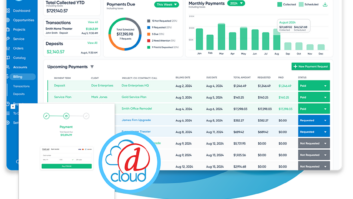Regular readers of this column are aware that I am a big proponent of metrics and using data to not only make decisions but to also ensure that the decisions made were the right ones. This month, we are going to dive into the custom installer’s world of data, which we are defining here as collective information related to a company and its operations. Mind you, data does not always have to be complex or even numerical — it can be as simple as notes taken during a project or feedback from clients.

The Importance of Data-Driven Decisions
Data-driven decisions are not just a corporate buzzword but a practical tool for better business outcomes. Some of the benefits of data-driven decision making include:
- Enhances Strategic Planning: Use data to forecast future trends, plan resource allocation, and prepare for market changes.
- Improves Risk Management: Helps identify potential risks before they become problems. For instance, historical data on product reliability can influence purchasing decisions and reduce the risk of delays.
- Increases Operational Efficiency: Data allows for analyzing processes to find inefficiencies. Tracking time spent on various tasks can reveal areas where processes can be streamlined, or automation can be introduced.
- Boosts Customer Satisfaction and Retention: By analyzing customer feedback and project outcomes, businesses can better meet client expectations and address areas of concern. Happy customers are more likely to buy again and refer others.
What can be measured can be improved, and the reverse is also true. It’s hard to improve something that is not being measured.
Five Common Areas of KPIs, Metrics, Data
The five common areas that can benefit from the use of KPIs, metrics, and data are Sales & Marketing, Project, Financial, Human Resources/Employment, and Recurring Revenue. Let’s take a quick look at each area.
Sales & Marketing Metrics
- Lead Flow: The number of leads over a selected timespan, which is a leading indicator of market health and future sales.
- Lead Sources: It is important to know where you get leads from and recognize the business’ pipelines.
- Close Rate: This is the big one — what percentage of deals close? You can analyze this one according to units sold or dollar amount.
- Opportunity Pipeline: How much potential business is available?
- Average Project Size: Key information for where to target your marketing efforts.
Project Metrics
- Billable/Non-Billable Time: Tracking this properly can help identify productivity issues both on and off the job.
- Change Order Value: This can help indicate profit opportunities or reveal design shortcomings.
- Go-Backs/Warranty: This metric can expose training opportunities.
- Actual vs. Budget: Analyzing the labor and equipment costs can show project profitability shortfalls — or celebrate windfalls.
- Client Satisfaction: Beyond the obvious referral opportunities, collecting this data shows maturity and transparency toward improvement.
Financial Metrics
At VITAL, we track about 30 financial metrics. We can’t fit all that here, but these are some of the major buckets.
- Revenue: This helps pay the bills. There are many ways of recording revenue, but we suggest it be based on produced work.
- Profitability: Profitability can happen at many levels, including gross margin by category and overall net profit.
- Cash Flow: This subcategory includes its own metrics subcategories such as customer deposits, accounts receivable, and inventory.
- Leverage: This includes financial ratios such as debt to equity.
- Equity: Speaking of equity…this is your company’s net worth. Does the data show that it is growing?
HR/Employment Metrics
Custom integration is a people-intensive business, and driving success for your team is crucial to long-term business success.
- Employee Turnover Rate: This one has its own formula: (# of separations/average employees over time) X 100.
- Time to Fill a Role: Plan ahead — this can be hard to do, especially for smaller companies that don’t hire often.
- Overtime Hours: This one is a financial metric and an HR metric, as it can indicate the need for additional staff and be used to predict burnout.
- Safety Incidents: This is often overlooked, but important — there is nothing worse than having your team on the sidelines from injury.
- Employee Satisfaction: Subjective and objective measures of employee satisfaction can help curb turnover.
Recurring Revenue Metrics
- Revenue Growth (MRR/ARR): Tracking revenue and growth by monthly recurring revenue (MRR) and annual recurring revenue (ARR) is necessary for proper planning
- MRR by Client/Address (ARPU): This data shows opportunities to grow within your existing client base. ARPU stands for Average Revenue Per User.
- Churn Rate: Knowing the percentage of cancellations within a specific period is crucial for maintaining revenue stability.
- Revenue Churn: This is the money lost due to churn over a specific period, which offers insight into how much the lost subscriptions are impacting the overall revenue.
- Client Lifetime Value (CLV): This data will help you make decisions about retention, marketing, and other factors.
Once you have reached a point where you are collecting the data —whether it be in a basic way such as a spreadsheet or more sophisticated software — you may want to see everything in one place. Some software systems already have dashboard capabilities, which I encourage you to leverage.
Of course, we are a bit biased toward the VITAL Financial Dashboards. We’ve simplified the data collection process and have benchmarks of performance we’ve collected over the last 15 years. Plus, our cloud-connected dashboards represent your business visually by connecting directly to your QuickBooks desktop or online file.
The key here is to keep things simple. Focus on data quality. While dashboards can help show improvement, understanding how to create good data is critical. After all, putting lipstick on crappy data doesn’t change crappy data!







